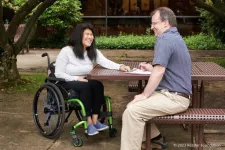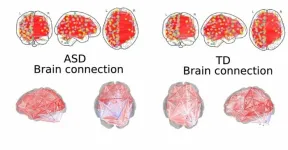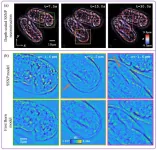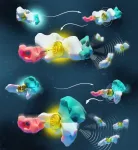(Press-News.org) LOS ALAMOS, N.M., Aug. 15, 2023 — A potentially game-changing theoretical approach to quantum computing hardware avoids much of the problematic complexity found in current quantum computers. The strategy implements an algorithm in natural quantum interactions to process a variety of real-world problems faster than classical computers or conventional gate-based quantum computers can.
“Our finding eliminates many challenging requirements for quantum hardware,” said Nikolai Sinitsyn, a theoretical physicist at Los Alamos National Laboratory. He is coauthor of a paper on the approach in the journal Physical Review A. “Natural systems, such as the electronic spins of defects in diamond, have precisely the type of interactions needed for our computation process.”
Sinitsyn said the team hopes to collaborate with experimental physicists also at Los Alamos to demonstrate their approach using ultracold atoms. Modern technologies in ultracold atoms are sufficiently advanced to demonstrate such computations with about 40 to 60 qubits, he said, which is enough to solve many problems not currently accessible by classical, or binary, computation. A qubit is the basic unit of quantum information, analogous to a bit in familiar classical computing.
Longer-lived qubits
Instead of setting up a complex system of logic gates among a number of qubits that must all share quantum entanglement, the new strategy uses a simple magnetic field to rotate the qubits, such as the spins of electrons, in a natural system. The precise evolution of the spin states is all that is needed to implement the algorithm. Sinitsyn said the approach could be used to solve many practical problems proposed for quantum computers.
Quantum computing remains a nascent field handicapped by the difficulty of connecting qubits in long strings of logic gates and maintaining the quantum entanglement required for computation. Entanglement breaks down in a process known as decoherence, as the entangled qubits begin to interact with the world outside the quantum system of the computer, introducing errors. That happens quickly, limiting the computation time. True error correction has not yet been implemented on quantum hardware.
The new approach relies on natural rather than induced entanglement, so it requires fewer connections among qubits. That reduces the impact of decoherence. Thus, the qubits live for a relatively a long time, Sinitsyn said.
The Los Alamos team’s theoretical paper showed how the approach could solve a number-partitioning problem using Grover’s algorithm faster than existing quantum computers. As one of the best-known quantum algorithms, it allows unstructured searches of large data sets that gobble up conventional computing resources. For instance, Sinitsyn said, Grover’s algorithm can be used to divvy up the runtime for tasks equally between two computers, so they finish at the same time, along with other practical jobs. The algorithm is well-suited to idealized, error-corrected quantum computers, although it is difficult to implement on today’s error-prone machines.
Protected against errors
Quantum computers are built to perform computations much faster than any classical device can do, but they have been extremely hard to realize so far, Sinitsyn said. A conventional quantum computer implements quantum circuits — sequences of elementary operations with different pairs of qubits.
The Los Alamos theorists proposed an intriguing alternative.
“We noticed that for many famous computational problems it is sufficient to have a quantum system with elementary interactions, in which only a single quantum spin — realizable with two qubits — interacts with the rest of the computational qubits,” Sinitsyn said. “Then a single magnetic pulse that acts only on the central spin implements the most complex part of the quantum Grover’s algorithm.” Called the Grover’s oracle, this quantum operation points to the desired solution.
“No direct interactions between the computational qubits and no time-dependent interactions with the central spin are needed in the process,” he said. Once the static couplings between the central spin and qubits are set, the entire computation consists only of applying simple time-dependent external field pulses that rotate the spins, he said.
Importantly, the team proved that such operations can be made fast. The team also discovered that their approach is topologically protected. That is, it is robust against many errors in the precision of the control fields and other physical parameters even without quantum error correction.
The paper: “Topologically protected Grover’s oracle for the partition problem.” Physical Review A. https://journals.aps.org/pra/abstract/10.1103/PhysRevA.108.022412
The funding: Department of Energy Office of Science, Office of Advanced Scientific Computing Research and the Laboratory Directed Research and Development program at Los Alamos National Laboratory.
-30-
LA-UR-23-29314
END
Novel hardware approach offers new quantum-computing paradigm
Using natural quantum interactions allows faster, more robust computation for Grover’s algorithm and many others
2023-08-15
ELSE PRESS RELEASES FROM THIS DATE:
New online course equips personal care assistants with essential knowledge for supporting individuals with spinal cord injury
2023-08-15
East Hanover, NJ – August 15, 2023 – "Understanding Spinal Cord Injury: A Course for Personal Care Assistants" a new interactive online course designed to enhance the training of personal care assistants (PCAs) for individuals with spinal cord injury, was presented today at the Paralyzed Veterans of America Healthcare (PVA) Summit + Expo at the Renaissance Orlando at SeaWorld Hotel in Orlando, FL, by Jeanne Zanca, MPT, PhD, FACRM, assistant director of the Center for Spinal Cord Injury Research at Kessler Foundation, and chair of the Foundation’s Institutional Review ...
Classic rock music can be recreated from recorded brain activity
2023-08-15
Researchers led by Ludovic Bellier at the University of California, Berkeley, US, demonstrate that recognizable versions of classic Pink Floyd rock music can be reconstructed from brain activity that was recorded while patients listened to the song. Published August 15th in the open access journal PLOS Biology, the study used nonlinear modeling to decode brain activity and reconstruct the song, “Another Brick in the Wall, Part 1”. Encoding models revealed a new cortical subregion in the temporal lobe that underlies rhythm perception, which could be exploited ...
Brain recordings capture musicality of speech — with help from Pink Floyd
2023-08-15
As the chords of Pink Floyd's “Another Brick in the Wall, Part 1,” filled the surgery suite, neuroscientists at Albany Medical Center diligently recorded the activity of electrodes placed on the brains of patients undergoing epilepsy surgery.
The goal? To capture the electrical activity of brain regions tuned to attributes of the music — tone, rhythm, harmony and words — to see if they could reconstruct what the patient was hearing.
More than a decade later, after detailed analysis of data from 29 such ...
Study proposes use of artificial intelligence to diagnose autism spectrum disorder
2023-08-15
Diagnosing autism spectrum disorder (ASD) is still a daunting challenge because of the degree of complexity involved, requiring highly specialized professionals. Autism is a multifactorial neurodevelopment disorder with widely varying symptoms. In the United States, about 1 in 36 children have been diagnosed with ASD, according to the Centers for Disease Control and Prevention (CDC), and yet there are no biochemical markers to identify it with precision. A quantitative diagnostic method is proposed by Brazilian researchers in an article published in ...
New algorithm captures complex 3D light scattering information from live specimens
2023-08-15
BOSTON - Researchers have developed a new algorithm for recovering the 3D refractive index distribution of biological samples that exhibit multiple types of light scattering. The algorithm helps optimize a new imaging approach called intensity diffraction tomography (IDT).
Jiabei Zhu from Boston University will present this research at the Optica Imaging Congress. The hybrid meeting will take place 14 – 17 August 2023 in Boston, Massachusetts.
“3D quantitative phase imaging (QPI) has superior features for various applications in the field of biomedical imaging. As a label-free technique, QPI ...
Advanced magnesium-based hydrogen storage materials and their applications
2023-08-15
As an energy carrier, hydrogen holds the prominent advantages of high gravimetric energy density, high abundance, and zero emission, yet its effective storage and transportation remain a bottleneck problem for the widespread applications of hydrogen energy. To address such an issue, different types of hydrogen storage materials are developed and carefully investigated in the past decades. Among them, magnesium hydride (MgH2) has been considered as one of the most promising hydrogen storage materials because of its high capacity, excellent reversibility, sufficient magnesium reserves, and low cost. However, the poor thermodynamic and kinetic properties ...
Decoding how molecules "talk" to each other to develop new nanotechnologies
2023-08-15
Two molecular languages at the origin of life have been successfully recreated and mathematically validated, thanks to pioneering work by Canadian scientists at Université de Montréal.
Published this week in the Journal of American Chemical Society, the breakthrough opens new doors for the development of nanotechnologies with applications ranging from biosensing, drug delivery and molecular imaging.
Living organisms are made up of billions of nanomachines and nanostructures that communicate to create higher-order entities able to do many essential things, such as moving, thinking, surviving and reproducing.
“The key to life’s emergence ...
Favored asylum seekers are young, female and fleeing war
2023-08-15
Russia’s attack on Ukraine has resulted in one of the largest movements of refugees since the Second World War. More than 7.4 million Ukrainians have sought asylum in Europe, almost three times the number of people who found refuge in Europe during Syria’s civil war in 2015 and 2016.
To investigate whether and how the willingness of host populations to receive refugees has changed since 2016, an international research team involving ETH Zurich, the University of California, Berkeley, and Stanford University surveyed 33,000 people in 15 European countries. The first wave of the survey took place in February 2016 and the second from May to June ...
More than 800 human-harvested shellfish species tend to be more resistant to extinction
2023-08-15
In a new study, scientists Stewart Edie of the Smithsonian, Shan Huang of the University of Birmingham and colleagues drastically expanded the list of bivalve species, such as clams, oysters, mussels, scallops and their relatives, that humans are known to harvest and identified the traits that make these species prime targets for harvesting. They also discovered that some of these same traits have also made this group of shellfish less prone to extinction in the past and may protect these shellfish in the future. The authors flagged certain ocean regions, such as the east Atlantic and northeast and southeast Pacific, as areas of special concern for management and conservation.
The ...
Nearly 50% of environmentalists abandoned Twitter following Musk’s takeover
2023-08-15
In October 2022, Elon Musk purchased Twitter (recently renamed X), which had previously served as the leading social media platform for environmental discourse. Since then, reports a team of researchers in the journal Trends in Ecology and Evolution on August 15, there has been a mass exodus of environmental users on the platform—a phenomenon that could have serious implications for public communication surrounding topics like biodiversity, climate change, and natural disaster recovery.
“Twitter has been the dominant social ...
LAST 30 PRESS RELEASES:
People with “binge-watching addiction” are more likely to be lonely
Wild potato follows a path to domestication in the American Southwest
General climate advocacy ad campaign received more public engagement compared to more-tailored ad campaign promoting sustainable fashion
Medical LLMs may show real-world potential in identifying individuals with major depressive disorder using WhatsApp voice note recordings
Early translational study supports the role of high-dose inhaled nitric oxide as a potential antimicrobial therapy
AI can predict preemies’ path, Stanford Medicine-led study shows
A wild potato that changed the story of agriculture in the American Southwest
Cancer’s super-enhancers may set the map for DNA breaks and repair: A key clue to why tumors become aggressive and genetically unstable
Prehistoric tool made from elephant bone is the oldest discovered in Europe
Mineralized dental plaque from the Iron Age provides insight into the diet of the Scythians
Salty facts: takeaways have more salt than labels claim
When scientists build nanoscale architecture to solve textile and pharmaceutical industry challenges
Massive cloud with metallic winds discovered orbiting mystery object
Old diseases return as settlement pushes into the Amazon rainforest
Takeaways are used to reward and console – study
Velocity gradients key to explaining large-scale magnetic field structure
Bird retinas function without oxygen – solving a centuries-old biological mystery
Pregnancy- and abortion-related mortality in the US, 2018-2021
Global burden of violence against transgender and gender-diverse adults
Generative AI use and depressive symptoms among US adults
Antibiotic therapy for uncomplicated acute appendicitis
Childhood ADHD linked to midlife physical health problems
Patients struggle to measure blood pressure at home
A new method to unlock vast lithium stores
Scientists unveil “dissolution barocaloric” cooling, opening new path to zero-carbon refrigeration
Microplastics in the atmosphere: Higher emissions from land areas than from the ocean
Metal clumps in quantum state: Vienna research team breaks records
PolyU develops new human-safe magnetorheological fibres, leading innovations in smart wearable textiles
Rice establishes Global Brain Economy Initiative in Davos, aligned with new report on brain health and AI
Quantum error correction with logical qubits
[Press-News.org] Novel hardware approach offers new quantum-computing paradigmUsing natural quantum interactions allows faster, more robust computation for Grover’s algorithm and many others








